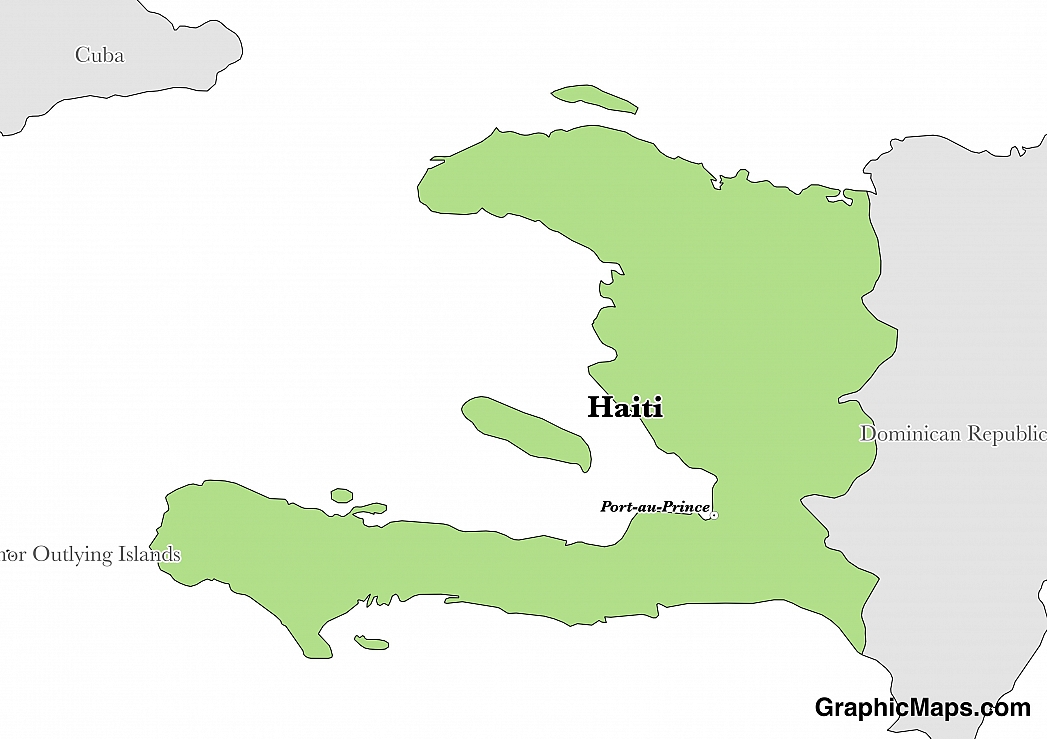Where is Haiti?
Located in the Caribbean, Haiti has a 376.00 km border with Dominican Republic (376 km). It has a 1,771.00 km coastline. Since 2004, peacekeepers of the United Nations Stablization Mission in Haiti have assisted in maintaining civil order in Haiti.
The capital city of Haiti is Port-au-Prince. The city was developed during the French colonial rule in 1749, and the Gulf-of-Gonave bay where the capital is located has helped sustain the economic activities in the region from immemorial past. The 2015 census revealed that the population of the city was 978,310. Port-au-Prince is a major tourist attraction center and the economic center of the country. Port-au-Prince enjoys a long-wet season running from March to November while the dry season is starts in December to February, with a break from the rains in July.
Read more on Haiti's CapitalHaiti is a North American country covering 27,750.00 km2 of which 0.68% is water and 27,560.00 km2 is land. This makes it the 52nd smallest country in the world and slightly smaller than Maryland. Its geographic coordinates are 19 00 N, 72 25 W and Port-au-Prince is the capital city.
The name Haiti, in native Taino, means "Land of High Mountains".
Its ISO code is HT.
Geography
Haiti has a mean elevation of 470 m above sea level.
It has a tropical climate which is semiarid in mountainous regions. its terrain is mostly rough and mountainous.
Population
Haiti has a population of 10,485,800 making it the 88th largest in the world. The country's population is evenly distributed throughout.
French is the official language. The major ethnicity reported is black. The majority of the country is Roman Catholic or Protestant Christian.
Haiti is one of the few countries in the Caribbean and the whole of Americas which has adopted French as their official language besides the Haitian Creole (the only other North American country to feature French as an official language is Canada). However, 40% of Haitians can converse in French, and the language is mostly used in media, business among other setups. The majority of Haitians converse in Haitian Creole, which is a unique local language. There are three dialects of the Haitian Creole - the southern, central, and northern Haitian Creole. Haitian Creole is a perfect blend of various West African languages, French, and Taino. This dialect exists only in the spoken form. Immigrants from the neighboring Dominican Republic are the main Spanish speakers in Haiti.
Read more on Haiti's LanguagesThe dialing code for the country is 509.
Government
Haiti is an independent country. It gained independence from France in 1804. Its constitution was last ratified in 1987.
The government of Haiti is a constitutional semi-presidential system of government, with both the president and the Prime Minister exercising executive power despite the prime minister's appointment by the president. The bicameral legislature is made up of the Senate and the Chamber of Deputies, all who are directly elected for a term period. The central government wields power that it only delegates to sub-governmental units. On a lower level, there is the local government which is subdivided further into a three-tiered hierarchical structure. The country goes to the election after a very five years, and as it is now, President Jovenel Moise will be seeking the second term of office through the ballot in 2021.
Read more on Haiti's GovernmentEconomy
Factoring in Purchasing Power Parity, Haiti's GDP is $19,340,000,000.00 (USD) with $1,800.00 (USD) per capita. This makes it the 146th largest economy and its citizens the 201st richest in the world. The currency of Haiti is the Gourde (HTG).
Its major export partner is the United States. Its main exports are apparel, manufactures, oils, and cocoa. Its major import partners are the Dominican Republic, the United States and the Netherlands. Its major imports include food, manufactured goods, machinery, and transport equipment.
Flag
The flag of Haiti is one with an eventful past. First cut from the French colonial flag, it retained the blue and red colors which were to signify the inhabitants of the country. Soon, a coat of arms was added bearing a trophy of weapons, as well as a royal palm which meant a readiness to defend the independence. The flag, however, saw many transformations as the country over the years, with ruling leaders frequently altering its design. Finally, the current flag was adopted in 1986. It features the blue and red horizontal bands of the original Haitian flag, with the coat of arms of the country in the middle
Read more on Haiti's FlagThis page was last modified on January 17th, 2018
More on Graphicmaps

Published on 2019-11-06
What is a Trade Embargo?

Published on 2019-11-04
Which Two Countries Used to Have the Same Flag?

Published on 2019-09-16
What Is the Only Two-Sided State Flag?

Published on 2019-09-16
Which Country Flag Looks Like the Texas Flag?

Published on 2019-08-29
Flags That Resemble the US Flag

Published on 2019-08-20
